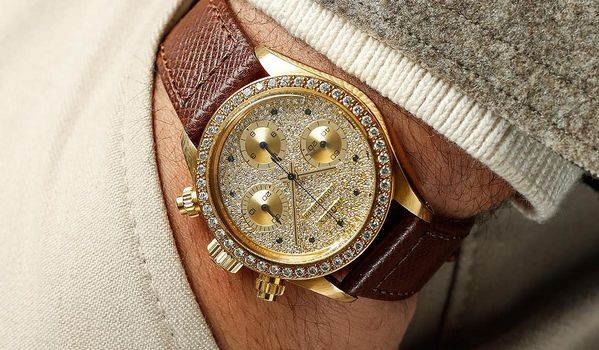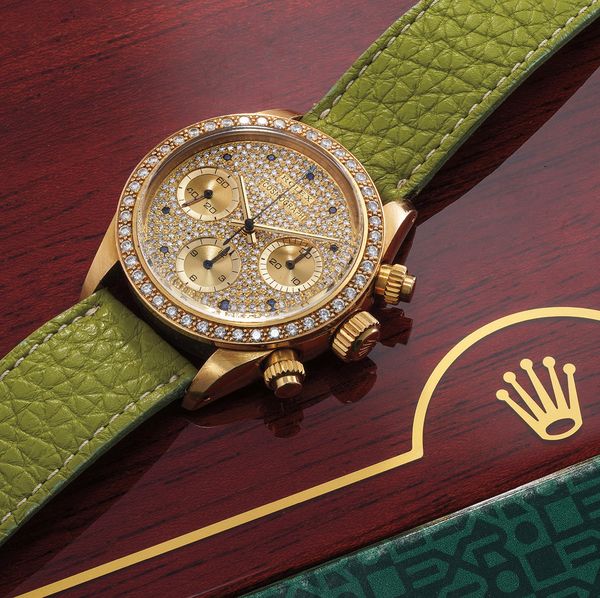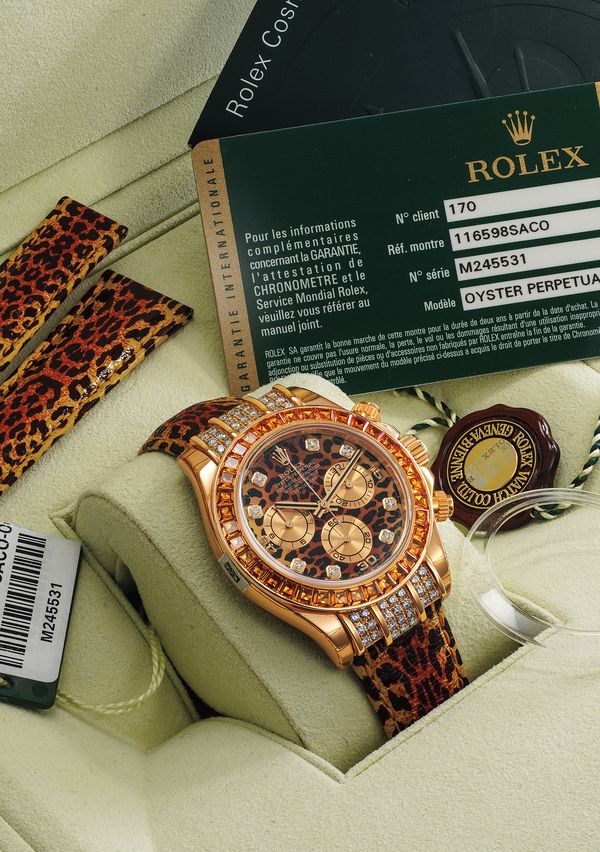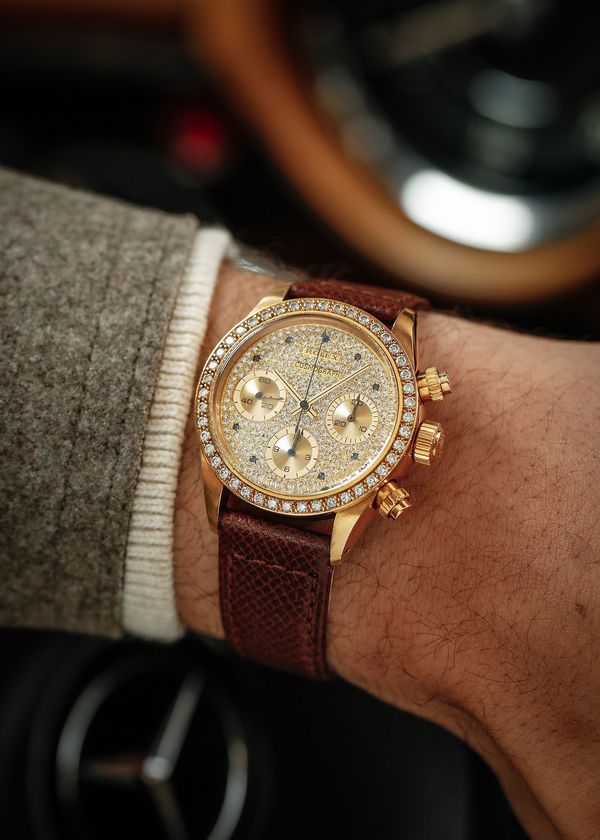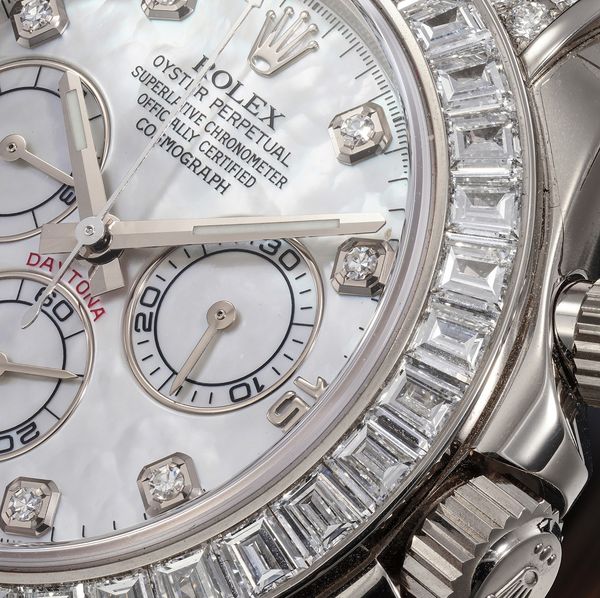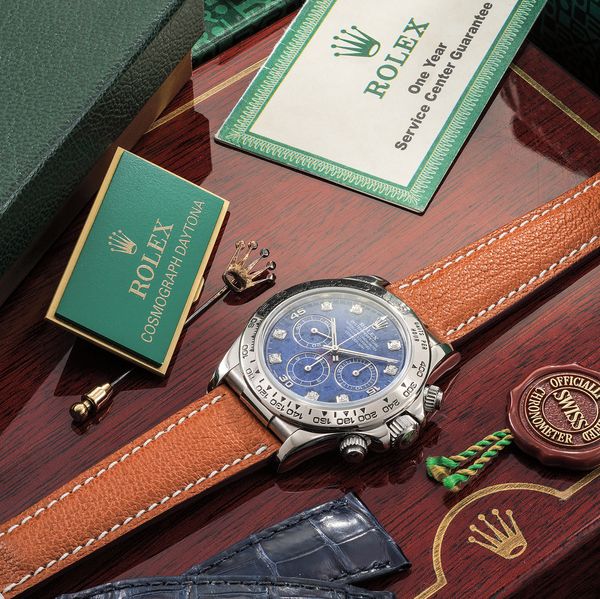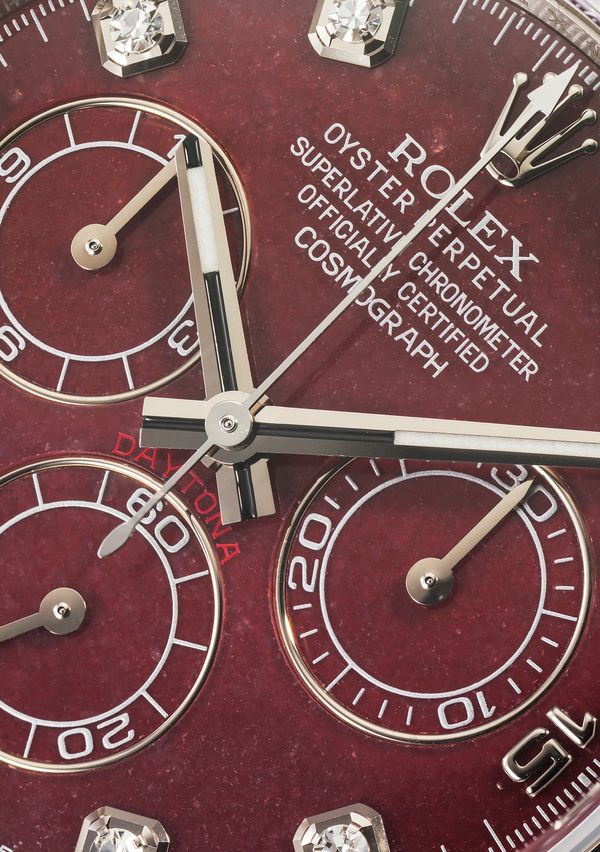Our first live auction of 2024, the PHILLIPS Geneva Watch Auction: XIX, takes place on May 11 and 12, at the Hotel President, at Quai Wilson 47 in central Geneva. The auction includes more than 215 of the world's finest watches – and though we are loath to boast, we truly think it's one of the best catalogs we've ever put together. We'll be highlighting a number of the most interesting lots and stories featured in the sale over the next month, including the Guido Mondani Collection pieces highlighted in this article.
- By Arthur Touchot
Sport watches and precious stones don’t sound like they go together, and yet, some watchmakers have managed to combine the two with exceptional results, to the point where one would be forgiven for no longer seeing some watches' more utilitarian and humble roots.
The brand that perhaps epitomizes this type of transformation is Rolex. The very few vintage and current gem-set pieces that bear the crown's logo are unlike anything the brand otherwise makes, and that has led to the rise of a niche of collectibles that attracts both experienced and new collectors – you can count industry titan Jean-Claude Biver as one of its biggest fans.
How Did We Get Here?
Gem-set sports watches have existed for longer than most of us think, and more than one path has led to this unexpected genre. Swiss manufacturers began experimenting, very tentatively at first, with the idea of luxury sports models during the late 1970s – a decade defined by the introduction of hybrid watches, mixing of technology, alloys, and styles.
Precious stones then gradually made their way into the collections of several high-end brands as the demand for more lavish styles increased, but for Rolex the change did not happen overnight. Unlike Audemars Piguet and Patek Philippe, Rolex did not introduce a brand new luxury sports watch that would redefine the brand’s positioning in one fell swoop. Instead, it took sports watch from its current collection - starting with the Submariner - and began slowly with a two-tone model featuring a few precious stones on the dial. The more difficult exercise of placing stones on a professional watch's case and/bracelet would come next.
Long before Rolex started placing stones on its professional watches, the brand had made another, perhaps even more radical move which was to start producing those same professional watches in 18K yellow gold.
While production of gold examples remained extremely low, precious metal GMTs, Submariners and Daytonas became available during the 1960s and 1970s, and while they were not particularly successful, commercially speaking, they introduced the idea of a potential crossover between the brand’s professional line, which had become synonymous with an adventurous, outdoors lifestyle, and its elegant dress watch collections.
In fact, while yellow gold GMTs, Submariners and Daytonas began making their entrance on the market, Rolex was gaining great experience with gem-setting watches through the Day-Date collection, which lent itself particularly well to this craft. In fact, it is one of the most elaborate pieces from that time period, the very rare “Octopussy”, that would become a symbol of what Rolex's expertise in gem-setting, as it is a model that presents a unique gem-set bracelet featuring both round-cut and baguette-cut diamonds, in addition to the more traditional placement of stones on the bezel and dial.
Bejewelled sports models arrived the following decade, during the 1980s, with the introduction of the first "serti-" dial Submariners, as well as the first gem-set GMT models. In both cases, the precious stones do more than enhance the watch’s look. In the former, they act as the hour markers, and in the latter, a combination of sapphires and rubies is used to re-create the watch’s distinctive red and blue bezel indicating the hours of the day and night.
Later in the same decade, Rolex introduced the first two bejewelled Daytonas references – the very rare and sought-after Ref. 6269 and 6270, which to this day remain the first and the only manually-wound Daytona models to feature precious stones. And this time, the stones were not just there to be useful, they were there to please.
Curiously, these two watches are the first gem-set sports watches to get their own unique reference numbers – both the SARU and the serti- Sub share their reference numbers with their then contemporaries, the yellow gold quick-set date GMT reference 16758 and the two-tone Submariner reference 16613.
The quick succession of launches suggests a rapidly evolving clientèle, whom Rolex obviously saw reacting well to the two-tone and the yellow gold versions of their tool watches, and who in turn clearly began thinking of the brand as a luxury maker.
So, while its clients (not to mention, its watchmakers) would certainly have been a little shocked by a gem-set GMT and Daytona, these were only the latest versions of watches that had already started their slow metamorphosis from tool to luxury watch.
Rolex would gradually add more gem-set References following the introduction of its first automatic Daytona models, and designs would become progressively more exotic – literally . Here’s the Ref. 116598 SACO aka “The Leopard” if you don’t believe us.
As one would expect from a manufacture known for their rigorously high standards, Rolex proved itself very particularly adept at creating gem-set watches, and it has caught the eye of many outside the realm of watchmaking.
Today the manufacture employs approximately 20 in-house gem-setters, and use only the very best stones available, by selecting stones of (IF) Internally Flawless quality. But these watches remained largely peripheral pieces in Rolex's catalogues.
Their rarity is one of several reasons why they have enjoyed a relatively peaceful existence away from the public’s eye, until recently. A number of stunning gem-set Rolex Daytona models are included in our upcoming Geneva Watch Auction: XIX – here are a few of the highlights.
Lot 13: A Circa 1985 Rolex Cosmograph Daytona Ref. 6269 From The Guido Mondani Collection
Showcasing a bezel set with 44 brilliant diamonds and pavé dial with 240 diamonds, reference 6269 is among the most regal, glamorous and luxurious Cosmograph models ever made. Research shows that Rolex made no more than thirty pieces in total. It is considered a trophy watch for many collectors. The top of the lugs are sharp, demonstrating how little if any intervention the watch has seen throughout its lifetime.
While today gem-set sports pieces are highly collectible and widely seen, these watches were only brought into the mainstream during the 2000s. In fact, these combinations of watchmaking and gem-setting have been recently rediscovered and are enjoying the popularity they truly deserve. However, only a few decades ago the market for bejewelled timepieces was a very different beast. Prior to that, gem-set sports watches were considered either a special order series, or one-off pieces. During the 1980s, Rolex adorned tool watches with precious gems for its most exclusive and demanding clientele, ranging from Sultans in the Middle East to industry titans. Rolex in particular excels in sourcing and setting gemstones. Alongside reference 6269 and its baguette diamond sibling reference 6270, the brand also developed a ruby, diamond and sapphire-set GMT-Master, known today as the “SARU”.
While the concept of merging gemstones with sports watches may seem obvious today, it was at the time a completely daring and maverick idea. Rolex forever changed the way we perceive and understand a tool watch, paving the way for endless possibilities and developments, such as the “Leopard” or the mythical emerald-set automatic Daytona. At the time, references 6269 or 6270 were mainly made for and worn by men. One can only imagine the debonair and well-heeled gentleman for whom Rolex specially produced this watch.
In fact, such a brave decision would probably not have been made by the company, if they had not been spurred by one of their most important - if not their most important ever - clients: His Highness Sultan Qaboos bin Said Al Said of Oman (1940-2020). It is under his specific request that the first two bejewelled Rolex sport references came to light. One, reference 6269, is distinguished by its brilliant-cut diamond bezel, diamond pavé dial and golden subsidiary counters. The other is the reference 6270 with a baguette-set bezel.
The present reference 6269 is an extremely impressive example, with crisp and sharp finishes on the top of the lugs. The hallmarks beneath the lugs are visible and deep, as are the numbers between the lugs. The dial itself is dazzling and bright; it is set with brilliant diamonds, as well as sapphires in lieu of hour markers. Such gems hardly appear on the market, no less in such well-preserved condition.
Lot 18: A 2007 Rolex Cosmograph Daytona ref. 116598SACO, "Leopard"
Introduced at Basel Fair in 2004, reference 116598 SACO immediately captured the eyes and hearts of Rolex fans. Set with diamond hour markers contrasting against a leopard print dial and strap, the watch was something entirely different than anything Rolex had conceived in the past. This print inspired the watch's nickname, "Leopard".
The watch is adorned with 36 baguette-cut yellow sapphires on the bezel, which are completely uniform, set incredibly close together and matching, which technically is no easy feat. The hoods between the lugs are also embellished with brilliant diamonds.

Presented in like-new condition with stickers on the caseband, caseback and clasp, this example is accompanied by its original guarantee, tag, presentation box and outer packaging.
Gem-set, precious sports watches are becoming increasingly collectible today, due to their good looks and robust proportions. Conspicuous, bold and audacious, this watch is a completely novel and interesting interpretation of the Cosmograph Daytona, making a bold statement about both Rolex and the collector who dons the timepiece.
Lot 31: A 2010 Rolex Cosmograph Daytona Ref. 116599TBR With Mother-of-Pearl Dial
It is incredible how a brand better known for its tool watches also makes some of the most delicately gem-set timepieces available on the market. During the 1980s, Rolex adorned tool watches with precious gems for its most exclusive and demanding clientele, ranging from Sultans in the Middle East to industry titans. Rolex in particular excels in sourcing and setting gemstones. Today, gem-set sports watches have come to represent the pinnacle of sports watch collecting.
Bedazzled with baguette-cut diamonds on the bezel and brilliant-cut diamonds on the lugs and dial, the watch is also fitted with a mother-of-pearl dial that adds to the splendour. Reference 116599TBR most notably has diamonds on the hooded lugs, which gives a slight design twist on the classic Cosmograph Daytona.
In excellent condition, rarely a sports watch has been embellished with such opulence.
Lot 147: A 1998 Rolex Cosmograph Daytona Ref. 16519 With Sodalite Dial
Rolex’s Cosmograph Daytona is one of the most iconic timepieces ever produced. Since it was first introduced in 1963, collectors and watch enthusiasts now long to own this model known for its masculine appeal and durability. Like other Rolex tool watches, the Daytona has undergone technical and design changes over the last nearly 70 years, however the base DNA has remained the same. Reference 16520 was launched in 1988 and took the watch world community by surprise. Until then, the Daytona was only available with a manually wound movement. With this reference, Rolex broke this tradition by introducing the automatic caliber 4030 based on a heavily modified Zenith El-Primero movement.
The reference 16519 was the white gold counterpart to the stainless steel 16520 – offered instead on a leather strap. The present example is fitted with a stunning and rare blue sodalite dial with diamond-set hour markers and is a wonderful example of Rolex seeking new innovative and imaginative ways to bring a new aesthetic to the Cosmograph Daytona. A pre-cursor to the beloved “Beach” series from the early 2000s, reference 16519s with hardstone dials show that experimentation with color is an expressive part of the Rolex way.
Preserved in excellent condition, the present model is a fine example of the rare hardstone dial Daytona Cosmograph.
Lot 202: A Circa 2009 Rolex Cosmograph Daytona Ref. 116509H With Rubellite Dial
In 2000, Rolex introduced the groundbreaking Cosmograph Daytona ref. 116520, featuring the firm's first ever in-house self-winding chronograph caliber 4130, replacing its former Zenith El Primero based caliber 4030. Entering into the new millennium with a bang, Rolex also introduced gold variants of the Cosmograph Daytona, and also for the first time were also offered with various dial materials, including hardstones. Rolex has always been at the innovative forefront when it comes to the experimentation of dial materials. Hardstone dials have always been a collector's favorite due to the fact that every dial is unique as it is natural. Various hardstones have differing natures, in terms of composition, luster and hardness, hence executing hardstone dials require extreme precision to execute.
This beautiful white gold Daytona is fitted with an incredibly attractive and rare rubellite dial with diamond-set numerals. The textured effect of the rubellite adds flair, movement and intrigue to the dial layout, and furthermore provides a perfect canvas for the diamond-set numerals to shine on. Moreover, most interestingly, the reference number is designated as reference 116509H - research suggests that the "H" refers to a non standard dial such as the present watch.
You can learn more about many of the above featured watches and register to bid on them by visiting the online catalog for the PHILLIPS Geneva Watch Auction: XIX.
A previous version of this article was published on PHILLIPS in 2020 and 2023.
About Phillips In Association With Bacs & Russo
The team of specialists at PHILLIPS Watches is dedicated to an uncompromised approach to quality, transparency, and client service. Phillips in Association with Bacs & Russo holds the world record for the most successful watch auction, with its Geneva Watch Auction: XIV having realized $74.5 million in 2021. Over the course of 2021 and 2022, the company sold 100% of the watches offered, a first in the industry, resulting in the highest annual total in history across all the auction houses at $227 million.
About Arthur Touchot
Arthur Touchot is a former journalist who specialized in the luxury market. Having earned a master’s degree in journalism at Northwestern University, Arthur combined his love of watches and words by becoming a regular contributor to The New York Times and the Financial Times at the start of his career, later becoming senior European editor at Hodinkee. In 2017, Arthur joined Phillips as International Head of Digital Strategy to lead the global content and digital marketing strategy of the auction house’s watch department, and has been involved in bringing some of the world’s rarest timepieces to auction.
Recommended Reading
